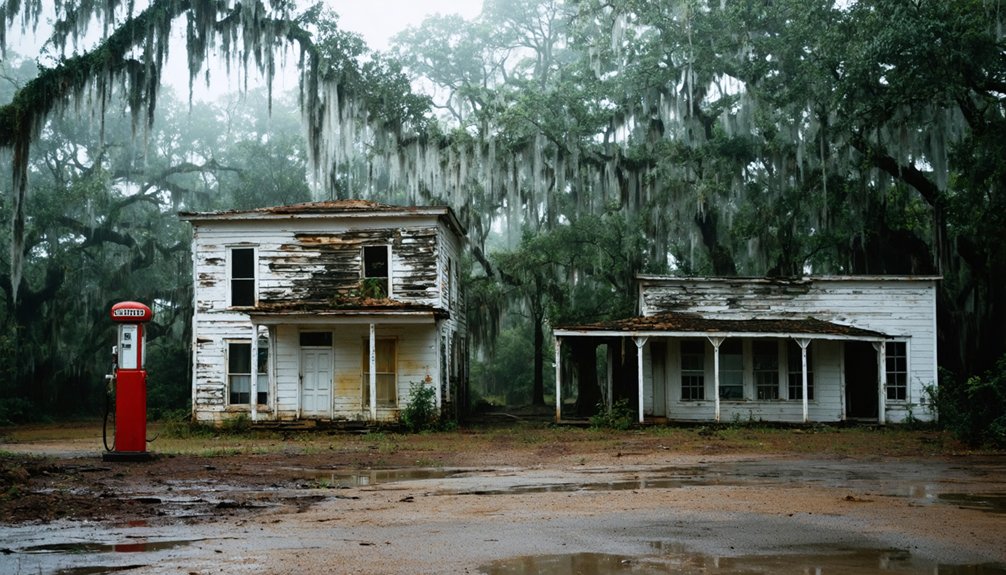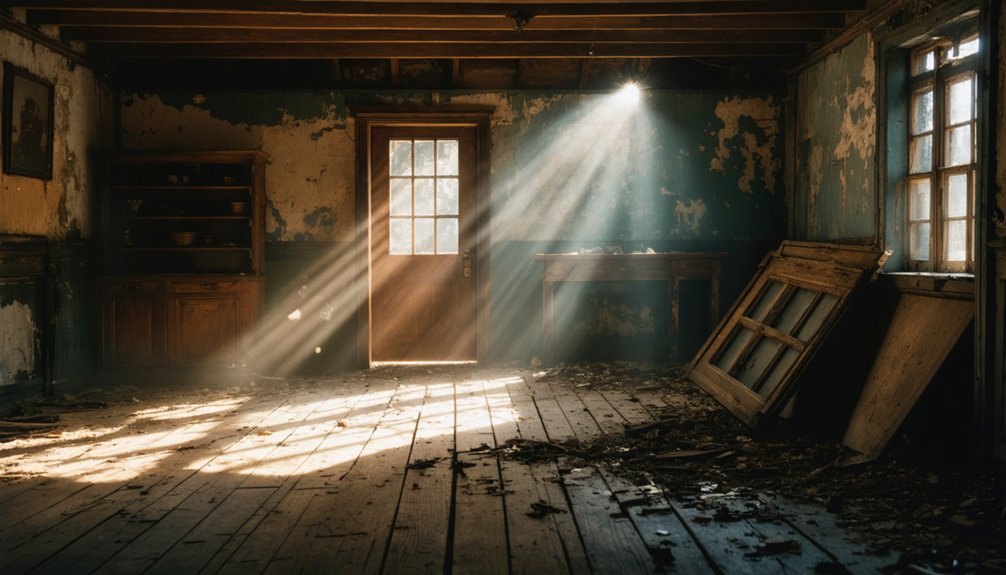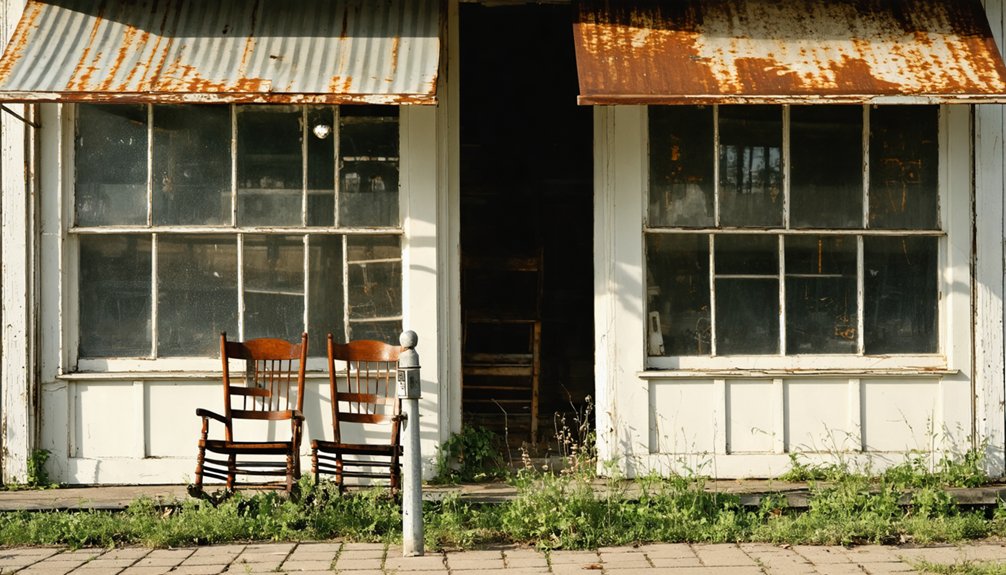You’ll discover Caddo, Texas along the historic El Camino Real, where ancient Caddo Indian settlements once thrived for over 3,000 years. Today, this ghost town features sacred burial mounds, ceremonial artifacts, and remnants of pioneer-era buildings that tell stories of both Native American culture and westward expansion. The site’s rich archaeological treasures and folklore create an atmospheric experience where the mysteries of the Hasinai people and early Texas settlers intertwine.
Key Takeaways
- Caddo, Texas exists today as a ghost town featuring remnants of historical buildings and structures from its previous settlement period.
- The town’s rich history includes significant Native American presence, particularly the Caddo people who settled in East Texas around 800 A.D.
- Visitors can explore abandoned structures while experiencing the atmospheric blend of history and mystery through local folklore and ghost stories.
- Archaeological discoveries at the site include sacred burial mounds and ceremonial artifacts from the sophisticated Caddo culture.
- The town’s remaining structures and historical sites are preserved for educational purposes, offering guided tours and research opportunities.
The Ancient Caddo Settlement Origins
When the Caddo people first settled in East Texas around 800 A.D., they established what would become one of North America’s most enduring indigenous territories.
You’ll find evidence of their remarkable 3,000-year presence along the region’s major waterways, particularly the Neches and Angelina River valleys, where they built thriving communities near Banita and Lanana Creeks.
Their success stemmed from mastering Caddo agriculture, cultivating tropical crops like corn, squash, and beans in the fertile river valleys. The socially ranked societies emerged by 900 A.D., developing complex civic and ceremonial centers throughout the region.
These agricultural practices formed the foundation for extensive Caddo trade networks that would later stretch across their vast 51,000-square-mile territory.
The Woodland Period ancestors left behind archaeological proof of their sophisticated farming and pottery-making skills, marking the beginning of a civilization that would flourish in East Texas’s Piney Woods for millennia.
The Native Americans constructed log cabins and mounds between the creeks, leaving lasting architectural evidence of their settlement patterns.
Sacred Mounds and Ceremonial Significance
The sacred mounds of the Caddo settlement stand as enduring monuments to their sophisticated spiritual practices, extending far beyond their agricultural achievements.
You’ll find two platform mounds that once supported grass-thatched temples where priests conducted sacred mound rituals, and a burial mound that housed elaborate tombs for elite members of society. The site was first documented by Athanase de Mézières while traveling through the region in 1779.
These earthworks weren’t just architectural feats – they served as the heart of Caddo religious life. The periodic burning and rebuilding of temple structures atop earlier remains symbolized spiritual renewal, while ancestral veneration played out through complex funeral ceremonies.
Today, you can walk the 0.7-mile interpretive trail connecting these ancient structures, which date back to 800 CE and stand as evidence to the rich ceremonial traditions of East Texas’s native peoples. This sacred site was actively used until around 1250 CE, when the Caddo people mysteriously abandoned their ceremonial center.
Life Along the El Camino Real
Along the ancient pathway now known as El Camino Real de los Tejas, Caddo communities thrived long before Spanish explorers first ventured into East Texas in 1689.
Ancient footsteps of the Caddo people marked these trails long before Spanish boots first crossed East Texas.
You’ll find traces of their settlements between the Trinity and Neches rivers, where the Nabedache and Neche Caddo built family farms and grass houses across 90-acre communities.
When Spanish expeditions arrived, they discovered a sophisticated network of indigenous trails that would become essential trade routes.
The dry mound prairies served as natural campsites, or parajes, where weary travelers could rest.
These settlements were part of a thriving civilization that maintained a vast trade network spanning multiple states.
While the Spanish established Mission San Francisco de los Tejas in 1690, attempting to convert the Caddo people, their efforts failed by 1693 due to disease and harsh conditions.
The route you can trace today along Highway 21 still bears witness to centuries of Caddo traditions and colonial encounters.
Today, the Caddo Mounds State Historic Site stands as a testament to the Caddo people’s heritage along this historic trail.
The Great Migration Westward
During the pivotal years between 1910 and 1970, over six million African Americans left their Southern roots behind, seeking better opportunities in Northern, Midwestern, and Western cities.
You’ll find this Urban Migration was driven by both push and pull factors. In the South, you’d face Jim Crow laws, racial violence, and economic hardship from the devastating boll weevil infestation that destroyed cotton crops. Approximately 500,000 blacks migrated northward between 1915 and 1920 alone.
The Great Migration accelerated during both World Wars when Northern factories desperately needed workers. If you’d headed north during this time, you’d find higher wages in automotive and steel industries, better educational opportunities, and relative racial safety. The Red Summer of 1919 marked a period of violent racial tensions and significant riots in major Northern cities.
Cities like Chicago and Detroit became beacons of hope, actively recruiting through newspapers like the Chicago Defender and sending labor agents southward.
Archaeological Discoveries and Cultural Treasures
You’ll find remarkable archaeological evidence at the Caddo site, where careful excavations have revealed sacred burial mounds containing charcoal-layered pits and ceremonial artifacts like decorated pottery and European trade beads.
The temple complex‘s layout, mapped through magnetometer surveys, shows at least seven ceremonial buildings and multiple circular structures ranging from 8 to 17.5 meters in diameter surrounding the main platform mounds.
The site’s rich collection of excavated treasures, including arrow points, large bifaces, and thousands of artifacts from daily and ceremonial life, helps reconstruct the sophisticated culture of these ancient Caddo people. Radiocarbon testing of over 100 samples indicates the Caddo settlement began in the 1300s.
Sacred Burial Mound Excavations
Sacred burial mounds at the Caddo site reveal intricate mortuary practices dating from 1100-1300 CE during the Mississippian period.
You’ll find carefully constructed burial pits containing human remains protected by distinctive charcoal layers, likely connected to the “Sixth Day Feast” burial practices and ceremonial feasts of the Caddo people.
The excavations have unearthed a wealth of cultural artifacts, from traditional Caddo ceramics to European glass beads, showing the site’s significance across centuries.
You can trace the continuous use of these sacred grounds through radiocarbon dating, which confirms activity through the 15th and 16th centuries.
A large cemetery area, once marked by ceremonial poles for important individuals, demonstrates the Caddo’s complex social structure and their dedication to preserving their ancestors’ resting places. TxDOT archaeologists carefully assess these cultural sites before any construction projects begin to ensure their preservation.
Temple Complex Layout Revealed
Several remarkable architectural features define the temple complex at Caddo, with the High Temple Mound standing as its spiritual and political epicenter.
You’ll find this massive structure once reached 35 feet in height, supporting various public buildings that were periodically burned and rebuilt as part of cultural rituals.
The temple architecture includes fascinating elements like the “Ceremonial Maze,” where ritual performances took place, and Building F35, a unique structure unlike any other in the Caddo world.
Near the High Temple, you’ll discover densely packed round houses measuring 25-45 feet in diameter, each housing up to 40 people.
The complex’s layout thoughtfully integrates domestic and ceremonial spaces, with the Low Platform Mound serving as a special ceremonial fire site – a representation of the sophisticated planning of this ancient community.
Ceremonial Artifacts Discovered
Archaeological excavations at the Caddo temple complex have revealed an extraordinary wealth of ceremonial artifacts that tell a compelling story of the community’s spiritual practices.
You’ll find thousands of ritual items including intricately decorated ceramic vessels, ceremonial bifaces, and arrow points that served both practical and symbolic purposes.
The discoveries paint a picture of complex ceremonial practices, with burial sites containing carefully placed charred offerings and evidence of fire rituals.
You can trace the ritual significance of these spaces through the deliberate placement of artifacts and the presence of protective charcoal layers above graves.
European glass beads found among traditional Caddo items show how their ceremonies evolved through cultural contact, while maintaining their core spiritual traditions.
Tales From Caddo Lake

The haunting waters of Caddo Lake hold centuries of mysteries, from its enigmatic formation to the tragic tales that ripple through local folklore.
You’ll find Caddo legends that speak of an ancient chief who defied the Great Spirit, triggering an earthquake that formed the lake. Ghost sightings often center around the ill-fated Mittie Stephens steamboat, where 64 souls perished in one of America’s deadliest inland boating accidents.
As you navigate through places like Whangdoodle Pass and Hog Wallow, you’re traversing waters shaped by the Great Raft – an 80-mile logjam that transformed the landscape.
The lake’s spirits include graceful apparitions from both Caddo and settler histories, while salvaged artifacts like the Mittie Stephens’ bell stand as silent witnesses to the lake’s dark past.
Preserving the Sacred Grounds
When you visit Caddo’s sacred grounds today, you’ll find careful preservation methods protecting the ancient earthen mounds and burial sites through partnerships between the Texas Historical Commission and modern Caddo communities.
Archaeological teams now employ non-invasive research techniques to study the site while respecting its cultural significance and preventing damage to fragile artifacts and features.
You’ll notice how the planned museum and interpretive trails balance public education with sacred site protection, ensuring these important heritage locations remain intact for future generations.
Heritage Site Protection Methods
Protecting sacred grounds within Caddo’s ghost town requires a multi-layered approach that combines legal frameworks, physical barriers, and community engagement.
You’ll find heritage protection measures that include surveillance systems, protective shelters, and designated pathways to prevent unauthorized access and environmental damage. The site’s conservation efforts rely on regular maintenance checks and non-invasive stabilization techniques to preserve original structures.
You can participate in local stewardship programs that connect you with the town’s rich history while ensuring its preservation for future generations.
When you visit, you’ll need to follow established codes of ethics and legal guidelines that protect against vandalism and artifact removal. The town’s historic landmark status mandates specific conservation protocols, supported by collaborative efforts between heritage managers and emergency services.
Modern Archaeological Conservation Approaches
Modern archaeological preservation at Caddo’s sacred grounds incorporates cutting-edge technology alongside time-tested conservation methods.
You’ll find advanced site documentation techniques utilizing drone mapping and virtual reality platforms that create detailed visualizations of the area’s historical features. These conservation techniques work hand-in-hand with indigenous practices, respecting traditional land management while ensuring structural stabilization of remaining artifacts.
The heritage protection strategy employs sophisticated archaeological methodologies, including 3-D laser scanning and photogrammetry, to monitor and preserve the site’s integrity.
Through active community engagement, local perspectives are woven into preservation efforts, creating a balanced approach to cultural sustainability. You can observe how protective shelters, designed by interdisciplinary teams, shield delicate remains while maintaining authenticity and spiritual significance.
Walking the Historic Trails Today

Today’s visitors to Caddo’s historic trails can explore both the ancient ceremonial grounds and cypress-laden bayous through an interconnected network of well-marked pathways.
You’ll find trail accessibility accommodates various comfort levels, from easy nature loops to more challenging archaeological segments. The visitor experience includes interpretive signs detailing Caddo Indian life from AD 800-1300, while marked routes guide you safely through swampy terrain.
At Caddo Lake State Park, you can walk the Pine Ridge Loop through mystical cypress forests, or venture onto paths that follow ancient Native American and Spanish colonial routes.
Don’t miss the historic Camino Real de los Tejas segment, where you’ll traverse a thickly wooded area above a bayou, connecting you directly to centuries of regional history.
Legacy of the Hasinai People
The Hasinai people’s complex social structure centered around the sacred role of the chenesi, who served as both religious leader and civil chief from their base in the Hainai village.
Their sophisticated confederation relied on tribal chiefs called caddis, supported by administrative officials who managed communal affairs and seasonal ceremonies.
You’ll find the Hasinai legacy deeply rooted in their spiritual practices, where the creator deity Caddi Ayo was honored through elaborate fire temple rituals.
Their cultural resilience shone through despite mounting pressures from European colonization and forced relocation.
Though displaced from their ancestral East Texas homeland to Oklahoma in 1859, the Hasinai maintained their identity within the broader Caddo Nation.
Today, their descendants continue traditional practices and assert tribal sovereignty in Caddo County, Oklahoma.
Modern Tourism and Cultural Heritage
While Wilson County boasts 31 ghost towns, Caddo stands out as a unique destination where natural splendor meets cultural heritage.
You’ll discover rich cultural tourism opportunities centered around Caddo Lake‘s mystique and the ancient Caddo Mounds State Historic Site, dating back to 800 AD.
Heritage preservation efforts have created engaging experiences that’ll connect you to the region’s past:
- The Graceful Ghost steamboat offers guided tours through cypress-laden waters, blending historical interpretation with natural wonder.
- Interpretive trails and educational signage at Caddo Mounds reveal indigenous history through preserved ceremonial grounds.
- Local folklore and ghost stories enhance your visit year-round, with guides sharing tales of mysterious creatures and unexplained phenomena that define this atmospheric destination.
Frequently Asked Questions
Are There Any Dangerous Wildlife Species Visitors Should Watch For?
With water depths reaching 20 feet, you’ll need wildlife safety awareness around American alligators in wetlands. Watch for venomous snakes, alligator snapping turtles, and check for ticks during visitor precautions.
What Are the Best Months to Visit for Comfortable Weather?
You’ll find the best months with comfortable weather during March-May and October-November, when temperatures stay moderate, humidity remains pleasant, and you’ll avoid summer’s intense heat and winter’s chilly days.
Can Visitors Bring Metal Detectors or Collect Artifacts From the Site?
You’d need a million permits before metal detecting here! It’s strictly regulated to protect artifact preservation – you’ll need written permission from landowners and proper permits from authorities to legally explore.
Are There Overnight Camping Facilities Available Near the Historic Site?
You’ll find plenty of campground options at nearby Caddo Lake State Park, including 46 sites for tent camping and RVs, plus historic cabins. The park’s within easy driving distance from Caddo’s ghost town.
Does the Site Offer Guided Tours in Languages Other Than English?
You won’t find multilingual tours at this location. Currently, all visitor experiences and guided tours are conducted exclusively in English, with no documented options for other language accommodations.
References
- https://en.wikipedia.org/wiki/Caddo_Mounds_State_Historic_Site
- https://www.texasbeyondhistory.net/tejas/voices/without.html
- https://www.nps.gov/places/caddo-mounds-state-historic-site.htm
- https://www.youtube.com/watch?v=JQrMFjZhOUs
- https://texashighways.com/outdoors/water/caddo-lake-inspires-legends-and-lore-in-east-texas/
- https://tpwmagazine.com/archive/2002/may/threedays/
- https://www.texasescapes.com/TexasTowns/Caddo-Texas.htm
- https://www.tshaonline.org/handbook/entries/caddo-lake
- https://www.texasescapes.com/SouthTexasTowns/Caddo-Texas.htm
- https://www.nactx.us/601/History-of-Nacogdoches



